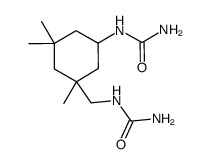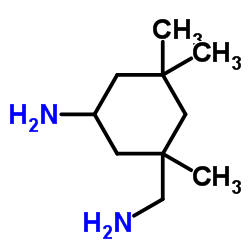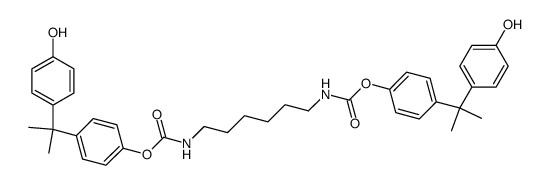UNII:43B0856528

UNII:43B0856528 structure
|
Common Name | UNII:43B0856528 | ||
|---|---|---|---|---|
| CAS Number | 4098-71-9 | Molecular Weight | 222.283 | |
| Density | 1.1±0.1 g/cm3 | Boiling Point | 286.9±13.0 °C at 760 mmHg | |
| Molecular Formula | C12H18N2O2 | Melting Point | -60°C | |
| MSDS | Chinese USA | Flash Point | 116.0±25.2 °C | |
| Symbol |



GHS06, GHS08, GHS09 |
Signal Word | Danger | |
| Name | isophorone diisocyanate |
|---|---|
| Synonym | More Synonyms |
| Density | 1.1±0.1 g/cm3 |
|---|---|
| Boiling Point | 286.9±13.0 °C at 760 mmHg |
| Melting Point | -60°C |
| Molecular Formula | C12H18N2O2 |
| Molecular Weight | 222.283 |
| Flash Point | 116.0±25.2 °C |
| Exact Mass | 222.136826 |
| PSA | 58.86000 |
| LogP | 4.67 |
| Vapour Pressure | 0.0±0.6 mmHg at 25°C |
| Index of Refraction | 1.520 |
| InChIKey | NIMLQBUJDJZYEJ-UHFFFAOYSA-N |
| SMILES | CC1(C)CC(N=C=O)CC(C)(CN=C=O)C1 |
| Stability | Reacts with all substances containing active hydrogen, such as acids, amines, water, phenols, mercaptans, amides, urea. Probably moisture sensitive. |
| Water Solubility | <0.1 g/100 mL at 25 ºC |
CHEMICAL IDENTIFICATION
HEALTH HAZARD DATAACUTE TOXICITY DATA
|
| Symbol |



GHS06, GHS08, GHS09 |
|---|---|
| Signal Word | Danger |
| Hazard Statements | H315-H317-H319-H330-H334-H335-H411 |
| Precautionary Statements | P260-P280-P284-P304 + P340 + P310-P342 + P311-P403 + P233 |
| Personal Protective Equipment | Eyeshields;Faceshields;full-face respirator (US);Gloves;multi-purpose combination respirator cartridge (US);type ABEK (EN14387) respirator filter |
| Hazard Codes | T:Toxic;N:Dangerousfortheenvironment; |
| Risk Phrases | R22;R36/37/38;R42/43;R51/53 |
| Safety Phrases | S26-S28-S38-S45-S61 |
| RIDADR | UN 2290 6.1/PG 3 |
| WGK Germany | 2 |
| RTECS | NQ9370000 |
| Packaging Group | III |
| Hazard Class | 6.1 |
| HS Code | 2929109000 |
| Precursor 5 | |
|---|---|
| DownStream 4 | |
| HS Code | 2929109000 |
|---|---|
| Summary | 2929109000. other isocyanates. VAT:17.0%. Tax rebate rate:13.0%. . MFN tariff:6.5%. General tariff:30.0% |
|
Correlating cell transfectability and motility on materials with different physico-chemical properties.
Acta Biomater. 28 , 55-63, (2015) Gene delivery into cells can be facilitated by adding plasmid DNA/transfection reagent complexes in culture medium or pre-adsorbing the complexes on the substrate before cell seeding. Using transfecti... |
|
|
Modelling the surface free energy parameters of polyurethane coats-part 1. Solvent-based coats obtained from linear polyurethane elastomers.
Colloid Polym. Sci. 291(4) , 1031-1047, (2013) Polyurethane elastomers coating were synthesised by using typical diisocyanates, polyether and polyester polyols and HO-tertiary amines or diols as a chain extenders. Mole fractions of structural frag... |
|
|
Polyurethane Microstructures--a Good or Bad in vitro Partner for the Isoflavone Genistein?
Nat. Prod. Commun. 10 , 951-4, (2015) In recent years polyurethane microstructures (PM) have gained increasing attention in the pharmaceutical field due to the importance of their practical application. Since finding that such a formulati... |
| 3-Isocyanatomethyl-3,5,5-trimethylcyclohexyl Isocyanate |
| 5-Isocyanato-1-(isocyanatomethyl)-1,3,3-trimethylcyclohexane |
| Isophorone diisocyanate |
| Cyclohexane, 5-isocyanato-1-(isocyanatomethyl)-1,3,3-trimethyl- |
| EINECS 223-861-6 |
| UNII:43B0856528 |
| MFCD00064956 |
| IPDI |
 CAS#:78632-23-2
CAS#:78632-23-2 CAS#:75-44-5
CAS#:75-44-5 CAS#:2855-13-2
CAS#:2855-13-2 CAS#:1266555-00-3
CAS#:1266555-00-3 CAS#:7051-17-4
CAS#:7051-17-4![(dibenzylamino) N-[3-[[(dibenzylamino)oxycarbonylamino]methyl]-3,5,5-trimethylcyclohexyl]carbamate structure](https://image.chemsrc.com/caspic/429/113659-04-4.png) CAS#:113659-04-4
CAS#:113659-04-4![2-[(5-isocyanato-1,3,3-trimethylcyclohexyl)methylcarbamoyloxy]ethyl 2-methylprop-2-enoate structure](https://image.chemsrc.com/caspic/370/73597-26-9.png) CAS#:73597-26-9
CAS#:73597-26-9 CAS#:59276-02-7
CAS#:59276-02-7
